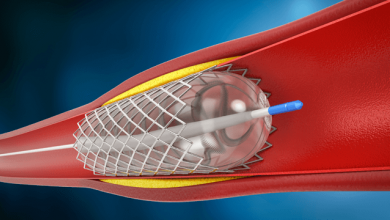Search results
TCT 23: AGENT IDE
Author(s):
Robert Yeh
Added:
5 months ago
Video
Author(s):
James Gilbart
Added:
3 years ago
In coronary artery stents, the coverage of the internal structures with neo-intimal formation has been regarded as a negative development leading to restenosis and loss of luminal space in the blood vessel. However, some coverage of the stent can be beneficial, providing coverage of protrusions in the internal stent structure that may otherwise constitute a thrombotic risk. Recent studies have…
View more
Author(s):
Adrian P Banning
,
Kristin L Hood
,
Aloke V Finn
,
et al
Added:
3 years ago
Patients with diabetes have abnormalities in the growth and function of arterial smooth-muscle and endothelial cells and consequently have a particularly aggressive and diffuse pattern of atherosclerosis, leading to increased cardiovascular complications and mortality compared with the non-diabetic population.1–4 However, the molecular signalling underlying the accelerated atherosclerosis in…
View more
Author(s):
Adnan Kastrati
Added:
3 years ago
Compared with conventional bare-metal stents (BMS), the introduction of drug-eluting stents (DES) has resulted in a substantial reduction in the incidence of in-stent restenosis.1 DES systems eluting either sirolimus2 or paclitaxel3 from a polymer stent coating have been shown in randomised trials to effectively inhibit the process of neointimal proliferation, resulting in restenosis reduction.
…
View more
Author(s):
Nikhil Pal
,
Jehangir Din
,
Peter O’Kane
Added:
3 years ago
The reduction in risk of cardiac death offered by revascularisation in patients with moderate to large amount of stress-induced myocardial ischaemia has driven advancements in percutaneous coronary intervention (PCI) technology over the last four decades.1 However, despite significant progress in the techniques, equipment and pharmacotherapy, target lesion failure remains the Achilles heel of a…
View more
Author(s):
Christoph Hehrlein
Added:
3 years ago
Percutaneous coronary interventions (PCI) for the treatment of coronary artery obstructions are associated with a high rate of restenosis (20–57%) in the first six months after the procedure.1,2 Metallic stenting has significantly improved short-term procedural outcomes and reduced restenosis rates in patients undergoing PCI.3,4 The surgical stent deployment procedure initially involves the…
View more
Author(s):
Bruno Scheller
,
Bodo Cremers
,
Stephanie Schmitmeier
,
et al
Added:
3 years ago
One of the most innovative fields of modern medical research is the percutaneous transluminal treatment of vascular disease. Coronary angioplasty was clinically introduced by Andreas Grüntzig in 1977.1 In the coronary field the most important improvement in angioplasty has been achieved with the introduction of stents. A significant proportion of complex modern coronary interventional techniques…
View more
Author(s):
Rhidian J Shelton
,
Daniel J Blackman
Added:
3 years ago
The introduction of coronary stents in the late 1980s improved outcome over balloon angioplasty via a reduction in acute vessel closure, prevention of vessel recoil, increase in acute gain and a lower rate of clinical restenosis.1,2 However, in-stent restenosis (ISR), caused by smooth-muscle cell proliferation and migration, leading to neointimal hyperplasia, remains the Achilles’ heel of bare…
View more
Author(s):
Angela Hoye
,
Scot Garg
Added:
3 years ago
Coronary artery bifurcations are at an increased risk of the development of coronary atherosclerosis because of turbulent flow and low shear stress. Bifurcation lesions account for between 8% and 22% of all percutaneous coronary interventions (PCI) and have long posed a problem for interventional cardiologists.
Published data show bifurcation lesions treated using bare metal stents (BMS) have…
View more
Author(s):
Nicolaus Reifart
,
Mariann Gyöngyösi
,
Karl-Eugen Hauptmann
,
et al
Added:
3 years ago
Coronary stent implantation is one of the most important developments in the field of percutaneous coronary revascularisation after the introduction of balloon angioplasty in 1977.1 The treatment of coronary artery disease (CAD) using a bare-metal stent (BMS) is considered effective; however, restenosis occurs in 15–35% of all cases, requiring repeated treatment.2–4 To overcome the restenosis…
View more











